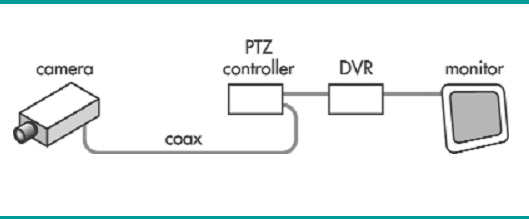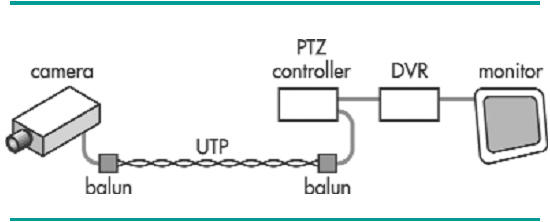Coaxial vs UTP, optic fiber for surveillance video transmission.
Currently, there are three major methods for surveillance video transmission, including coaxial cable, un-shielded twisted pair (UTP) cable, optical fiber and wireless…etc. Each of methods with cons and pros, can suitable for different applications, varies video transmission distance or differ image quality, with several years experience in installation of video surveillance cameras, herein we explain three main methods for video transmission.
Coaxial cable transmission

Transmit base-band video signals (or video signal) through coaxial cable
Baseband video signals is normally called video signal, its bandwidth is 0-6MHz. Generally, the higher of frequency of signal, the more of attenuation of signal during transmission, when design surveillance system just need to consider the amplitude of the high frequency signal. The signal attenuation at 5.8MHz as below: SYV75-3 cable 30dB/1000 meters, SY75-5 19dB/1000M, SYV75-7 13dB/1000M; If need to transmit high quality images, under without interference, 75-3 coaxial cable only can transmit 100 meters, 75-5 160M, 75-7 200M; For long range transmission, can adopt video signal amplifier equipment, to amplify and compensate the video signal, maximum transmission distance reach up to 2-3km.
Additionally, one coaxial cable not only can transmit video signal, but also can transmit control signal simultaneously, herein we make simple introduction for this technology.
In CCTV system, there are two kinds of signal for transmission; video signal, and control signal. Video signal is conveying from camera to monitoring center (or DVR); control signal is conveying from monitoring center to camera (including lens, PTZ control); coaxial cable transmit video and control signal technology is using one coaxial cable for transmission video signal and control signal to control lens and PTZ…etc function, this kind of transmission method can save cost during installation and maintenance, with flexibility.
- Adopting frequency splitting technology, means modulate the control signal’s frequency, which differ from video sigal, transmit out with combination of video signal via coaxial cable, then modulate signal at camera for getting control signal.
- Transmit control signal during the blanking period of the video signal. Similar like TV broadcast, insert the control signal into the blanking period of the video signal, the monitor will not display the blanking period, thus control signal will not interfere images. Through signal amplifier, can extend signal transmission distance, If adopting 75-5 coaxial coaxial cable, it can transmit signal at 2000 meters distance, 75-7 can reach up to 3.5km, 75-9 can extend to 5km for both video and control signal.
Transmitting RF signal via coaxial cable
Modulation of video signal to high frequency for video transmission, similar to cable television. Adopting this technology, the system with advantages of simple cable layout, anti-interference, but maintenance is hassle, because one coaxial cable transmitting multiply signal, also need to go through signal amplifier, easy to case crossing interference.
Un-shielded twisted pair (UTP) cable

Using the un-shielded twisted pair cable for video transmission is popular during recent years. Un-shielded twisted pair cable is also called Cat5 Ethernet cable, compared with coaxial cable, this technology with obvious advantages:
- Easy cable layout, efficiency. A traditional Cat5 Ethernet cable consists of 4 twist pair cable, can transmit 4 video signal at same time, or 3 video signal and 1 signal
- Low cost. Cat5 cable is more cheaper than coaxial cable like 75-3, outdoor waterproof Cat5 cable’s price is same like 75-5, but Ethernet cable can transmit multiply video signal, thus it’s more economic.
- Long range transmission distance. Using video balun to amplifier video signal, the transmission distance can reach up to 1.5km.
- Strong anti-interference.
- UTP cable also can transmit digital video signal, that means it works with IP cameras. With UTP connection, you can easy to move CCTV system to IP system with exist UTP cable.
Some notice for UTP connection
- The principle for choosing UTP cable: Choosing the Cat5 cable or un-shielded Ethernet cable, each cable contains 8 cores, resistor value should not exceed 15Om/100 meters.
- For different transmission distance, with different solution, such as commercial building, typically distance not exceed 150 meters, can choose passive video balun; distance at 650 meters, can choose passive video balun at camera, active video balun at DVRs (signal receiving devices);distance between 650m to 1.5km, need to use active video balun at both sides (camera and DVR).
- For outdoor usage, make sure choosing weatherproof (waterproof) Ethernet cable, this can ensure system’s reliability.
If you want to know more about difference between coaxial and UTP connection, please read this PDF file .
Optical fiber transmission method
Using the optical fiber to replace coaxial cable for video transmission, optical fiber transmission can transmit large data video signal at long distance with fast speed and lowest interference. For optical fiber transmission, you need to use fiber transceivers.
- Long distance transmission, Single-mode fiber’s signal attenuation is 0.2dB – 0.4dB per killo meters.
- Large data, can transmit up to dozens channels of video signal. If use of multicore fiber, then the capacity doubled.
- Video quality is high, due to the optic fiber transmission doesn't need amplifier for long range transmission, thus without superimposed non-linear distortion and noise for video transmission. Coupled with strong anti-interference performance of optical fiber system and without interference from outside temperature changes, can ensure high quality of image transmission.
- Main disadvantage is the high cost, difficulty and complexity of cable construction and layout.
Tags: CCTV Tips, UTP, Optic Fiber